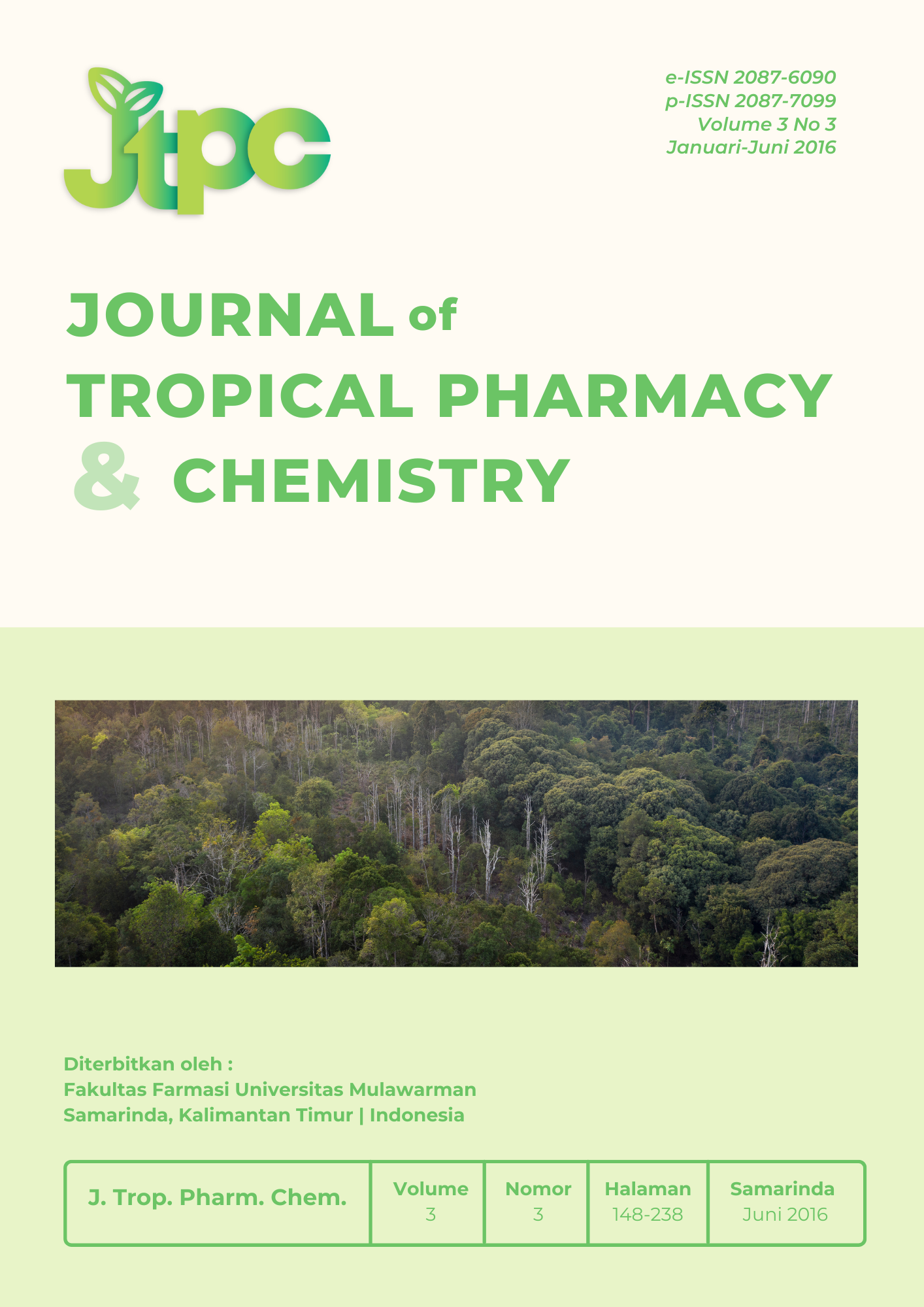Hubungan Jumlah Obat yang Digunakan terhadap Risiko Terjadinya Drug-Related Problems pada Pasien Asma Di Suatu Rumah Sakit Di Surabaya
Keywords:
asthma, drug-related problem riskAbstract
Asthma is a chronic inflammatory disorder of the respiratory tract are at risk of polypharmacy, which is associated with an increased risk of drug-related problems (DRPs) and adverse clinical outcomes. This study aimed to analyze the relationship between the amount of drug used with the incidence of DRPs in hospitalized asthma patients. Research were using retrospective methods, by analyzing the medical records of patients undergoing asthma hospitalizations for 2 years. The number of patients analyzed was 60 people. Results of research conducted by the Spearman test for non-parametric tests, show that there is a correlation between the amount of drug to the type of drugs that are less precise DRPs (p <0.05), so that more and more types of drugs used by patients with asthma, the greater the risk of patients getting the drug less appropriate. Therefore it takes the role of pharmacists in monitoring and recommending rational drug for asthma patients who underwent inpatient in a hospital, for treatment obtained by the patient effective and optimal.
Downloads
References
1. Global Initiative for Asthma. Global Strategy for Asthma Management & Prevention (Update) 2015.
2. Asthma Management Handbook. National Asthma Counil Australia. 2006.
3. Mangunrejo H, Widjaja A, Kusumo D, Sutoyo, Yunus F, Pradjnaporamita, et al. Pedoman Diagnosis dan Penatalaksanaan di Indonesia: Asma, Perhimpunan Dokter Paru Indonesia. 2004.
4. DiPiro J, Talbert R, Yee G, Matzke G, Wells B, Posey M, editors. Pharmacotherapy: A Pathophysiologic Approach. 6th ed. United States: McGrawHill; 2005.
5. Abdelhamid E, Awad A, Gismallah
A. Evaluation of a Hospital Pharmacy-Based Pharmaceutical
Care Services for Asthma Patients. Pharmacy Practice 2008; 6(1):25-32.
6. McDonald VM, Simpson JL, Higgins I, Gibson PD. Multidimensional assessment of older people with asthma and COPD: clinical management and health status. Age and Ageing 2011;40(1):42-49.
7. Veehof LJ, Stewart RE, Meyboom- de Jong B, Haaijer-Ruskamp FM. The development of polypharmacy: A longitudinal study.Family Practice 2000; 17(3):261-267.
8. Koh Y, Kutty FBM, Li SC. Drug- related problems in hospitalized patients on polypharmacy: the influence of age and gender. Therapeutics and Clinical Risk Management 2005; 1(1): 39–48.
9. Veehof LJ, Stewart RE, Meyboom- de Jong B, Haaijer-Ruskamp FM. Adverse drug reactions and polypharmacy in the elderly in general practice. Eur J Clin Pharmacol 1999;55(7):533-6.
10. Bootman L. Drug Related Morbidity and Mortality Impact of Pharmaceutical Care, World Health Organization: Essensial Medicines and Policy Department (EDM): International Conferences on Improving Use of Medicines (ICIUM) 2007.
11. Kirsten K Viktil, Hege S Blix, Tron A Moger, Aasmund Reikvam. Polypharmacy as commonly defined is an indicator of limited value in the assessment of drug-related problems. Br J Clin Pharmacol 2007; 63(2):
187–195.
12. Cipolle R, Strand L, Morney P. Pharmaceutical Care Practice. United States: McGrawHill; 1998.p76-80.
13. Mill FV. Drug-related Problems: A Cornerstone for Pharmaceutical Care. Journal of the Malta College of Pharmacy Practice. 2005; 10.
14. American Society of Health-System Pharmacists. ASHP Guidelines on a
Standardized Method for Pharmaceutical Care. Am J Health- Syst Pharm 1996; 53:1713–6.
15. Corelli RL, Kradjan WA, Koda- Kimble MA, Young LY, Guglielmo BJ, Alldredge B. Assessment of Therapy and Pharmaceutical Care. Dalam Koda-Kimble MA, Young LY, Kradjan WA, Guglielmo BJ, Corelli RL, eds. Applied Therapeutics: The Clinical Use of Drugs, 8th ed. Philadelphia: Lippincortt Williams & Wilkins;2005. p1.1-1.21.
16. Rovers JP, Currie JD, Hagel HP, McDonough RP, Sobotka JL, ed. A Practical Guide to Pharmaceutical Care,2nd ed.Washington DC: American Pharmaceutical Association;2003. p160-162.
17. Blix H, Vitkil K, Asmund R, Tron M, Bodil H, Piia P, et.al. The Majority of Hospitalised Patients Have Drug-Related Problems: Result from A Prospective Study in General
Hospitals, European Journal of Clinical Pharmacology 2004; 60(9).
18. Viktil K, Blix H, Moger T, Reikvam
A. Polypharmacy as Commonly Defined is an Indicator of Limited Value in the Assessment of Drug- Related Problems. British Journal of Clinical Pharmacology, British Journal of Clinical Pharmacology 2006; 63(2):187-195.
19. British Medical Association. British National Formulary 53. Royal Pharmaceutical Society of Great Britain; 2007.
20. Lacy C, Armstrong L, Goldman M, Lance L. Drug Information Handbook: A Comprehensive Resource for all Clinicians and Healthcare Professionals, 14th ed,. United States: Lexi-Comp Inc; 2006.
21. Baxter K, ed. Stockley’s Drug Interactions, 7th ed. London: Pharmaceutical Press; 2006. p 1-11,
697.




